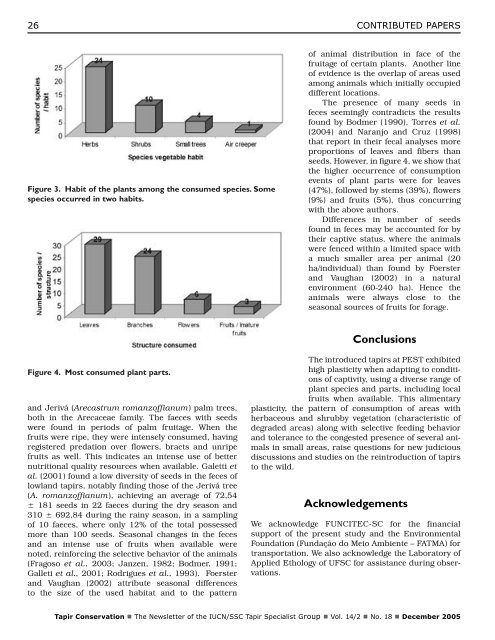Tapir Conservation - Tapir Specialist Group
Tapir Conservation - Tapir Specialist Group
Tapir Conservation - Tapir Specialist Group
Create successful ePaper yourself
Turn your PDF publications into a flip-book with our unique Google optimized e-Paper software.
26<br />
Figure 3. Habit of the plants among the consumed species. Some<br />
species occurred in two habits.<br />
Figure 4. Most consumed plant parts.<br />
and Jerivá (Arecastrum romanzoffianum) palm trees,<br />
both in the Arecaceae family. The faeces with seeds<br />
were found in periods of palm fruitage. When the<br />
fruits were ripe, they were intensely consumed, having<br />
registered predation over flowers, bracts and unripe<br />
fruits as well. This indicates an intense use of better<br />
nutritional quality resources when available. Galetti et<br />
al. (2001) found a low diversity of seeds in the feces of<br />
lowland tapirs, notably finding those of the Jerivá tree<br />
(A. romanzoffianum), achieving an average of 72,54<br />
± 181 seeds in 22 faeces during the dry season and<br />
310 ± 692,84 during the rainy season, in a sampling<br />
of 10 faeces, where only 12% of the total possessed<br />
more than 100 seeds. Seasonal changes in the feces<br />
and an intense use of fruits when available were<br />
noted, reinforcing the selective behavior of the animals<br />
(Fragoso et al., 2003; Janzen, 1982; Bodmer, 1991;<br />
Galleti et al., 2001; Rodrigues et al., 1993). Foerster<br />
and Vaughan (2002) attribute seasonal differences<br />
to the size of the used habitat and to the pattern<br />
of animal distribution in face of the<br />
fruitage of certain plants. Another line<br />
of evidence is the overlap of areas used<br />
among animals which initially occupied<br />
different locations.<br />
The presence of many seeds in<br />
feces seemingly contradicts the results<br />
found by Bodmer (1990), Torres et al.<br />
(2004) and Naranjo and Cruz (1998)<br />
that report in their fecal analyses more<br />
proportions of leaves and fibers than<br />
seeds. However, in figure 4, we show that<br />
the higher occurrence of consumption<br />
events of plant parts were for leaves<br />
(47%), followed by stems (39%), flowers<br />
(9%) and fruits (5%), thus concurring<br />
with the above authors.<br />
Differences in number of seeds<br />
found in feces may be accounted for by<br />
their captive status, where the animals<br />
were fenced within a limited space with<br />
a much smaller area per animal (20<br />
ha/individual) than found by Foerster<br />
and Vaughan (2002) in a natural<br />
environment (60-240 ha). Hence the<br />
animals were always close to the<br />
seasonal sources of fruits for forage.<br />
Conclusions<br />
The introduced tapirs at PEST exhibited<br />
high plasticity when adapting to conditions<br />
of captivity, using a diverse range of<br />
plant species and parts, including local<br />
fruits when available. This alimentary<br />
plasticity, the pattern of consumption of areas with<br />
herbaceous and shrubby vegetation (characteristic of<br />
degraded areas) along with selective feeding behavior<br />
and tolerance to the congested presence of several animals<br />
in small areas, raise questions for new judicious<br />
discussions and studies on the reintroduction of tapirs<br />
to the wild.<br />
Acknowledgements<br />
CONTRIBUTED PAPERS<br />
We acknowledge FUNCITEC-SC for the financial<br />
support of the present study and the Environmental<br />
Foundation (Fundação do Meio Ambiente – FATMA) for<br />
transportation. We also acknowledge the Laboratory of<br />
Applied Ethology of UFSC for assistance during observations.<br />
<strong>Tapir</strong> <strong>Conservation</strong> n The Newsletter of the IUCN/SSC <strong>Tapir</strong> <strong>Specialist</strong> <strong>Group</strong> n Vol. 14/2 n No. 18 n December 2005










